Trending Assets
Top investors this month
Trending Assets
Top investors this month
Confluent Q1 2023 Earnings Review $CFLT

Following their Q1 earnings report on May3rd, Confluent stock jumped by 16% the next day. Since then, CFLT has continued appreciating, recently passing their previous high for 2023. While the report itself was pretty good (but not outstanding), the market appears to be anticipating more growth to come. Perceived AI tailwinds are likely at play. In order to capitalize on the potential advantages from advanced insights and new proprietary AI models, enterprises need access to all their data in one place. It should be filtered, consistent and recent. As the leading independent provider of data streaming, and soon stream processing capabilities, Confluent is well positioned to address this demand.
Fortunately, Confluent doesn’t have to convince most enterprises of the value of real-time data streaming. Over 75% of the Fortune 500 already use Apache Kafka at some level to accomplish this. Confluent’s task is to demonstrate that their data streaming platform, which offers many enhanced capabilities over self-managed open source Kafka, is worth the incremental cost. While this may have been a more difficult sell in the corporate data center, Confluent Cloud provides enterprises with a managed solution on their hyperscaler of choice, eliminating the need to maintain a large team of operations engineers with Kafka expertise.
Additionally, stream processing tools allow data engineers to filter, transform and aggregate data in flight, front-loading processing before it arrives at its destination. The most popular open source solution for stream processing is Apache Flink. With their acquisition of Immerok in January, Confluent is now integrating a managed Flink stream processing toolset into their core Cloud platform. Management expects that revenue from stream processing could eventually match that of core data streaming, effectively doubling their TAM.
While their Q1 results continued to reflect the pressure of elongated deal cycles and enhanced scrutiny, Confluent managed to deliver subscription revenue growth over 40% y/y. For the remainder of 2023, they maintained revenue targets at conservative levels. Profitability measures dipped in Q1 due to a couple of one-time charges, but are tracking towards break-even operating margin in Q4. That will represent another 2000 bps of annual improvement. Long term, the Confluent management team sees FCF margin reaching 25%.
Revenue growth is primarily being driven by expansion of Confluent’s largest customers, with continued increases in $1M+ commitments and even anecdotal references to $5M-$10M of annual spend. Confluent’s NRR rate remains above 130% overall, with NRR for just Cloud well above that. Confluent needs to keep the new customer pipeline flowing, as focus has shifted to Kafka migrations and workload expansions within existing customers.
Confluent’s revenue target for this year represents about 1% of their calculated $100B addressable market, leaving plenty of room for future expansion.
In this post, I review Confluent’s product strategy and discuss several new announcements. Most exciting is the early access program for Confluent’s stream processing offering. Then, I will parse the Q1 results and discuss the trends that appear to be driving the recent outperformance in CFLT stock. For interested readers, I have published a couple of prior posts on Confluent, which provide more background on the investment thesis.
Confluent’s Product Strategy
As enterprises consider how to leverage new AI models to generate better business insights, they are realizing they have access to mountains of proprietary data internally. Competitive advantage in the effectiveness of AI is conferred to the organization with access to the richest dataset. For companies in specialized fields, like healthcare, communications, transportation, finance, media and others, their proprietary data sets can perform better than AI models loaded with data generally available on the Internet (if that even exists in some cases).
In order to harness this data, the first step for enterprises is to ensure it is readily available in a central store. Besides providing an argument for a modern data warehouse, centralizing data requires establishing feeds from all the hundreds of systems and applications that produce it. Ideally, data flows are as up-to-date as possible, with filtering, transformation and aggregation applied in flight. This system of real-time data pipelines can be served by a data streaming platform, with stream processing support built into it.
Fortunately, this use case has been addressed for many years by Apache Kafka for data streaming and Apache Flink for stream processing. These solutions have been adopted by large enterprises, with Kafka already enjoying greater than 75% adoption by the Fortune 500. Flink is a popular solution with enterprise developers as well, and complements Kafka nicely.
Confluent sells a cloud-native, feature complete and fully managed service that provides development teams with all the tools needed to support real-time data streaming operations. The platform has Apache Kafka at the core, supplemented by Confluent’s additional capabilities to make Kafka easier to scale, manage, secure and extend. Some of these value-add features include visualization of data flows, data governance, role-based access control, audit logs, self-service capabilities, user interfaces and visual code generation tools.
In order to deepen their offerings for stream processing, Confluent announced their intent to acquire Immerok back in January. Immerok was founded in 2022 and includes the leading contributors to Apache Flink. Immerok’s primary product is a cloud-native version of Apache Flink. As a fully managed, serverless offering, Immerok Cloud provides customers with an easy way to run Apache Flink without setting up their own infrastructure.
The Confluent team has been rapidly working to integrate a managed service for Flink into the Confluent Cloud offering. They recently announced an early access program for Confluent’s new managed services with Apache Flink. When discussing the acquisition, Confluent management predicted that the revenue stream from the Apache Flink managed service could approach that for core Kafka over time.
All of these features are designed to simplify the effort of streaming data from multiple sources to multiple destinations within an enterprise’s data infrastructure. Further, stream processing allows data engineering teams to act on the data while it is in flight, preventing delays in applying transformations on arrival.
As more producers and consumers are introduced into an organization’s data infrastructure, flows cannot be managed through traditional one-to-one, batched data pipelines. A many-to-many system based on the publish-subscribe model becomes necessary.
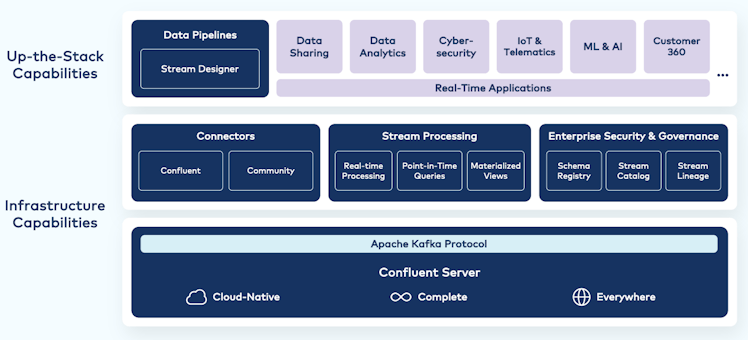
For organizations that rely on a continuous stream of data to function, Confluent provides the underlying data infrastructure. Use cases extend beyond obvious applications like in financial markets and AdTech. As enterprises realize the benefits of optimizing their business operations and performance through data mining and machine learning, then broader and faster distribution of data in near real-time yields incremental benefits. Confluent is leveraged by leaders in multiple industries to address an expanding set of use cases like fraud analysis, transportation/logistics, healthcare, supply chain management and telecommunications.
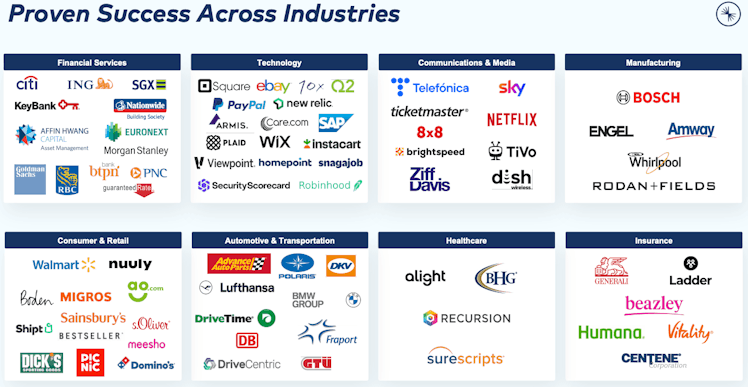
At a high level, the investment thesis for Confluent’s growth revolves around the reality that Kafka usage is already widespread among enterprises. If you agree that data represents a critical input to competitive advantage in AI models, then Confluent occupies an important component of a modern data infrastructure. During their Investor Session at the annual Current conference in October 2022, leadership shared that more than 100k organizations worldwide currently use Apache Kafka. This includes over 75% of the Fortune 500.
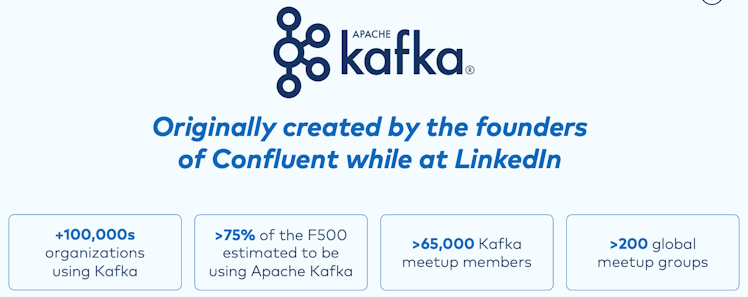
Of the Fortune 500, most of the largest companies in each industry utilize Kafka for data streaming. Kafka was developed at LinkedIn and open sourced in 2011. It graduated from the Apache incubator program in October 2012 and has been broadly available since then, allowing it to grow into the most popular data streaming platform. As a data platform, Kafka is sticky. Once an enterprise builds data infrastructure on top of it, the cost of switching to another solution is high. This explains the broad adoption. Additionally, its timing was favorable, as the decade of 2010 was when most enterprises updated their data infrastructure to enable this type of distribution for new Internet and mobile-delivered applications.
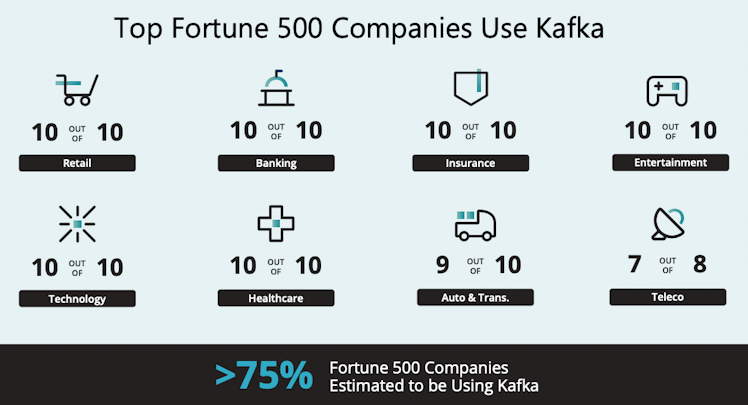
Since Kafka usage is prolific, Confluent’s challenge and opportunity is to convert this installed base to the commercial version of Kafka that they provide. To justify the upgrade, the Confluent team has built additional, proprietary functionality around the core Kafka distribution. These address tricky problems in scalability, security, management and ease of integration with data producers and consumers.
These capabilities are only available to customers who subscribe to Confluent’s distribution. If the customer is self-hosted, they download and install the enhanced Confluent package onto their servers. If using Confluent Cloud, management is seamless as the Confluent team handles all operations for the customer. Of all open source software infrastructure options, I can tell you that Kafka is one of the most difficult to manage, requiring dedicated engineers well-versed in the nuances of running large data infrastructure at scale.
Besides Confluent, the hyperscalers offer hosted Kafka services. AWS has Amazon Managed Streaming for Apache Kafka (MSK), which is a fully managed, highly available Kafka implementation. AWS offers a separate proprietary product called Kinesis, that is a data streaming processing engine. This is not based on Kafka, but leverages many of the same concepts around the publish-subscribe pattern. Azure and GCP offer data streaming solutions, but also have strong partnerships with Confluent for managed Kafka.
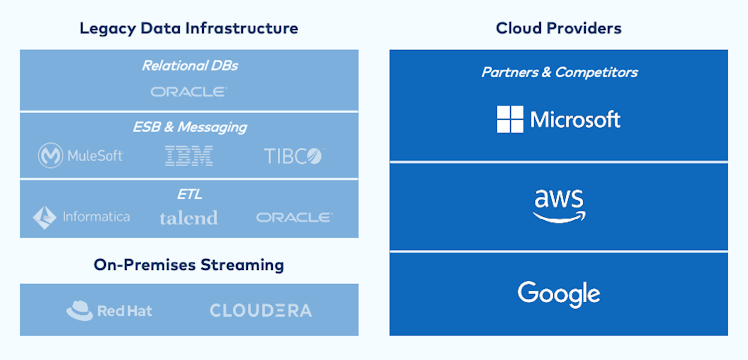
Amongst the hyperscalers, Confluent Cloud distinguishes itself by offering more add-on services and broader availability than any of the cloud providers’ solutions. The hyperscaler products are usually just cloud-hosted versions of Kafka with a few extensions and integrations into their internal services. For customers with a multi-cloud deployment, being able to access the same Kafka installation across different cloud providers and on-premise systems represents a big advantage. This cross-cloud capability would be limited for any of the individual hyperscaler offerings, as the breadth of working connectors would always be lacking (even if they claim otherwise).
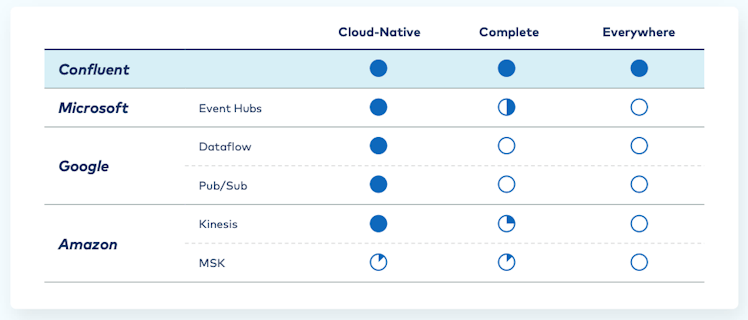
To attract these Kafka users to the Confluent offering, the product team emphasizes three categories of advantage:
- Cloud Native. Kafka has been redesigned to run in the cloud. The Confluent Cloud solution comes with tools for DevOps, serverless configuration, unlimited storage capacity and high availability.
- Complete. Confluent has added features in a number of areas that provide supplemental capabilities not available in open source Kafka. These are designed to appeal to developers, allowing them to reliably and securely build next generation applications more quickly. These include over 120 connectors to other popular systems, stream governance, enterprise security, monitoring, ksqlDB and stream processing. As mentioned, Apache Flink will soon be generally available to further enhance stream processing capabilities in the managed service.
- Everywhere. Confluent Cloud is available on AWS, Azure and GCP. Confluent Platform is also available for customers that self-host their infrastructure. Cluster linking provides a bridge to connect instances across different cloud providers or to physical data centers. For any large enterprise with infrastructure that spans multiple cloud providers and their own self-hosted systems, Confluent provides the broadest reach of integrations. It would be risky for an organization to rely just on a hyperscaler solution for data streaming in the event they require working connectors to other cloud services.
For Confluent Cloud, the advantage to customers is that all aspects of managing the Kafka instance and adjacent services are handled by Confluent. With self-managed installations or Kafka cloud hosting from other providers, the IT organization is left to manage most or some of the functions in the Kafka installation.
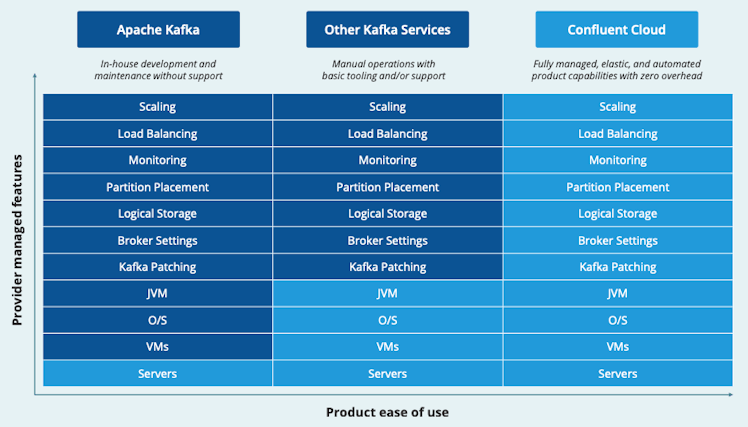
With Confluent Cloud, the customer outsources all aspects of managing the Kafka instance to the Confluent team. These include partitioning, scaling, software patches and monitoring. Provisioning, configuring and running a Kafka cluster at high data volumes can be very complex. Having the engineering team that wrote the software managing one’s infrastructure is a big help. Resources that were dedicated to running the Kafka installation can be redeployed onto projects that create real competitive advantage for enterprises.
Due to this inherent advantage, the hyperscalers have been increasingly partnering with Confluent. AWS signed an expanded agreement in January 2022. Azure soon followed in April 2022. GCP and Confluent have a long-standing relationship. As with other independent software companies, the hyperscalers are discovering the advantages of partnering with these providers versus trying to compete with them. For Confluent, they enjoy the benefit of healthy and productive relationships with all three major hyperscalers (versus gravitating towards one or two).
To calculate the market opportunity, the Confluent team used a bottoms-up approach. They looked at their three customer segments, calculated the target population for each and then assigned an average ARR target. Admittedly, their budget estimates are on the high side, but they do have existing customers with these spending levels.
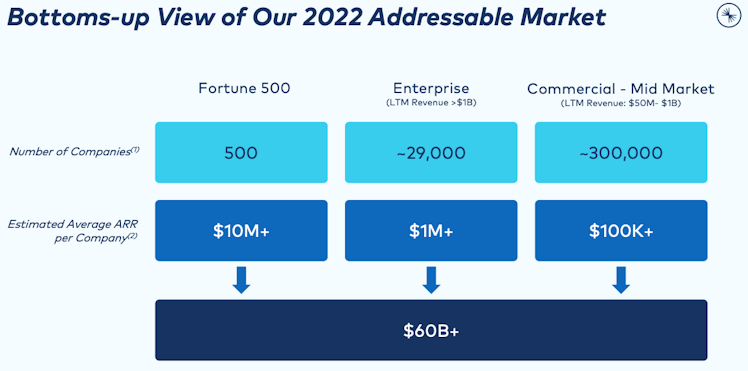
This exercise generated a $60B market opportunity in 2022. Using Gartner market data, they further predict a CAGR of 19% from 2022 to 2025. This yields a target addressable market of $100B by 2025, of which Confluent is currently less than 1% penetrated.
To reach these spending levels, Confluent employs a typical “land and expand” motion. Customers start by experimenting with a single data flow. They proceed to add more data flows that are disconnected. Often, the initial cases are non-critical or can tolerate some latency. Over time, expectations for reliability and speed increase. Eventually, Confluent is handling all real-time data flows and becomes the high availability backbone for the organization’s data operations.
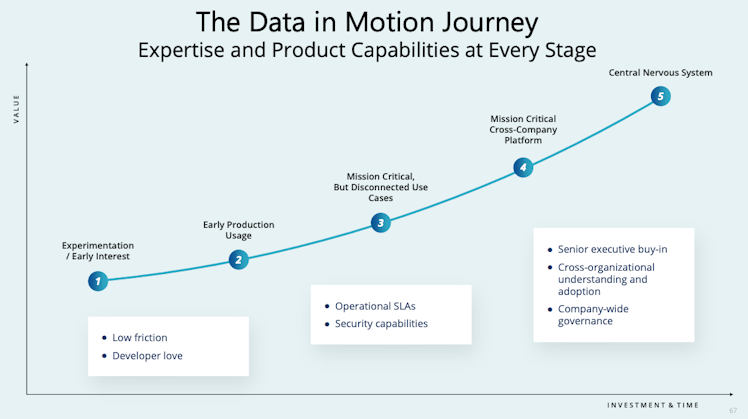
Recent Product Announcements
In mid-May, Confluent made a couple of significant product announcements. The most exciting development for investors is an early access program for Confluent’s new managed service for Apache Flink. This product offering makes advanced stream processing capabilities available over Confluent’s core data streaming platform. Stream processing enables users to filter, join and aggregate data in real-time, while it is being streamed. It allows downstream data consumers to make use of the data immediately, versus needing to perform these data processing functions first. For high throughput and low latency data distribution systems, in-flight processing is necessary to scale.
These capabilities were gained by Confluent through their acquisition of Immerok in January. Confluent leadership estimates that the revenue contribution for stream processing could eventually reach that of their core data streaming products. Leadership had previously indicated that a managed Flink service would be available by end of 2023. This early access program represents the first step towards the GA product, allowing select Confluent Cloud customers to try the service and help shape the product roadmap. Given the potential to generate a new revenue stream in 2024, I am happy to see Confluent take this first step.
Other new product announcements include:
- Data Quality Rules. As organizations scale their use of real-time data streaming, it is critical that data contracts between upstream and downstream components can be enforced. Data quality rules provide a method to ensure data compatibility and integrity. Part of Confluent’s Stream Governance module, data quality rules support validation of individual fields, mechanisms to resolve incompatibilities and migration rules for transformation of message formats.
- Custom Connectors. Some organizations maintain their own custom applications and systems that they want to connect to data streaming. Previously, configuring and managing connectors from Kafka to these custom data sources created a lot of manual overhead for the infrastructure team. With Custom Connector support, Confluent has made this process more automated. An organization can upload their custom connector into Confluent Cloud, where it can be accessed and managed like any other connector. The team will also have access to logs and metrics in order to monitor the performance of their connector.
- Stream Sharing. This capability provides organizations with tools to share data across teams internally and externally, leveraging the same data streaming platform. This use case makes a lot of sense for Confluent to address, as the data is already being formatted and streamed for real-time distribution. In order to facilitate data sharing use cases, Confluent improved controls for authenticated sharing, access management and layered encryption. They also extended data quality and compatibility rules to data sharing pipelines.
- Kora Engine. The Confluent team has invested heavily to build their own processing engine for Apache Kafka, customized for the cloud. Called Kora, it supports multi-tenancy and serverless abstractions, decoupled networking-storage-compute layers, automated operations and high availability globally. With the Kora engine, Confluent Cloud customers can scale with 30x faster performance, leverage unlimited retention and protect data with a 99.99% SLA.
These capabilities should help organizations speed up their transition to real-time data streaming. In parallel to these announcements, Confluent released the results of a survey on data streaming trends. Conducted by a third-party, the survey queried 2,250 IT leaders who are using data streaming in their organizations. Respondents spanned seven countries and represented mid-size to large enterprises across all major industries. The goal was to understand how data streaming is being adopted, future plans and any obstacles to use.
Investors can read the full report without a registration required. Here are some of the primary take-aways that support the Confluent investment case:
- Most Users of Data Streaming are Still Early on the Maturity Scale. For each of the 2,250 respondents who are using data streaming in some capacity, Confluent established 5 levels, indicating their level of maturity. The majority of users are categorized as Level 2 or 3, indicating that there is still ample expansion in these organizations as they mature their usage.
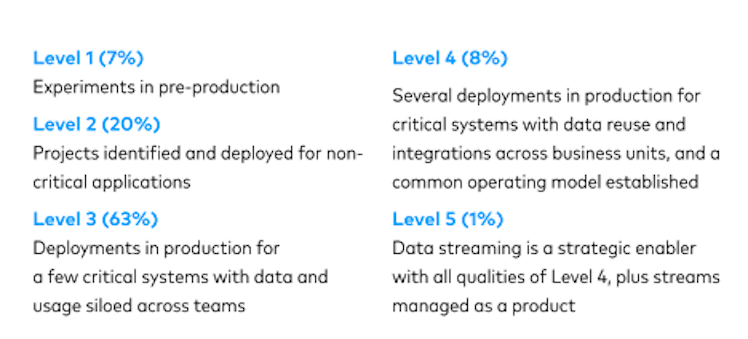
- Prioritization of Data Streaming is High. Of respondents, 44% ranked data streaming as one of their top strategic priorities and another 45% described it as important.

- Favorable ROI. As organizations establish more mature data streaming practices, they report higher levels of return on investment (ROI) from their efforts. Level 4 and 5 users experience an ROI of 5x or more on average. Even less mature organizations see significant ROI, with Level 2 and 3 organizations averaging 2-5x ROI.
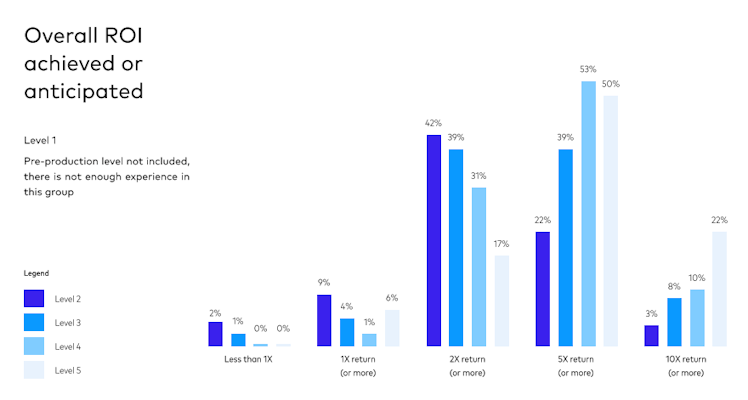
While the survey is scoped to a controlled audience of data streaming users, I find the results encouraging. The primary take-away is that Confluent can use this data to demonstrate to new customers the value in expanding their usage up the maturity curve.
Increasing the maturity of customer adoption of data streaming correlates to revenue expansion. In the past, Confluent management has provided many examples of customers with significant elasticity in their spending levels. At their Current conference in October 2022, leadership highlighted several companies. These examples include multiples in spend of 8x to 31x over a relatively short period of time (5-6 years for the largest increases).
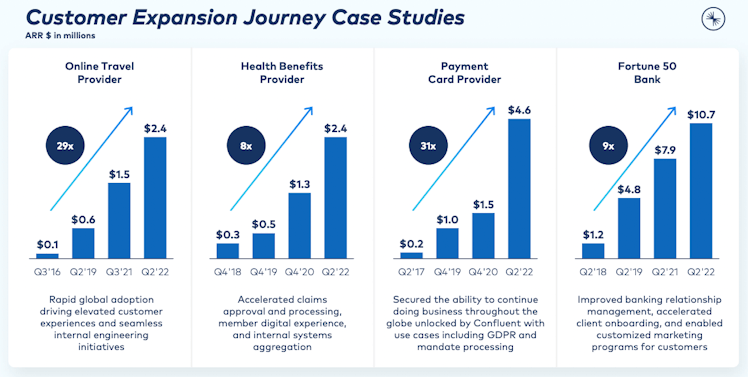
If we look at one example with the Fortune 50 Bank, Confluent leadership laid out the rapid expansion progression over 4 years to $10M in annual spend. They even think the customer has a line of sight to $20M in ARR. This customer illustrates the progression through the 5 levels of maturity in data streaming, where the organization moved from level 1 to level 4. During this period, their spend increased by a factor of 10 in the transition from level 2 to level 4, and are now a $10M+ customer.
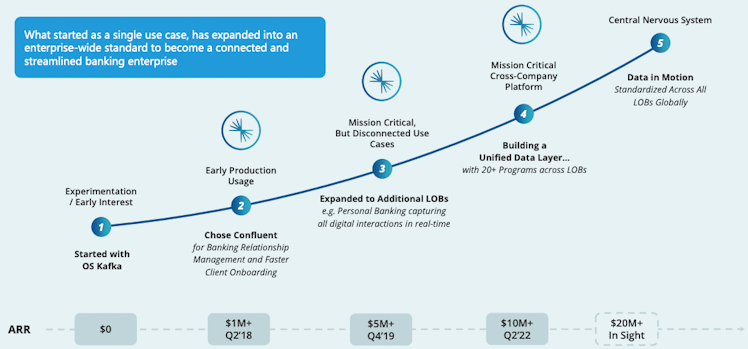
Confluent leadership thinks this customer could reach $20M+ in spend as they progress to level 5 maturity. To have a single customer approaching $20M in annual spend is significant. That one customer would represent over 3% of total revenue for 2022. With 133 customers now above $1M+ spend and a doubling of $5M+ customers in FY2022, we can see why Confluent’s focus on growing their largest customers makes sense. Based on the survey data, Confluent sales can make a compelling case to the customer’s engineering leadership that they will gain a high return on their investment as they continue to expand use of Confluent solutions.
Q1 Earnings Results
Confluent reported Q1 earnings on May 3rd. The market liked the results, as the stock shot up 16.2% from its 3 month low under $20 to just over $23. For the week following earnings, CFLT stock stayed in the same post earnings range of $22-$23. Recently, it has surged above $29 and is near its 2023 high. CFLT’s 52 week peak is above $34 and the all-time high from November 2021 is $93.60.
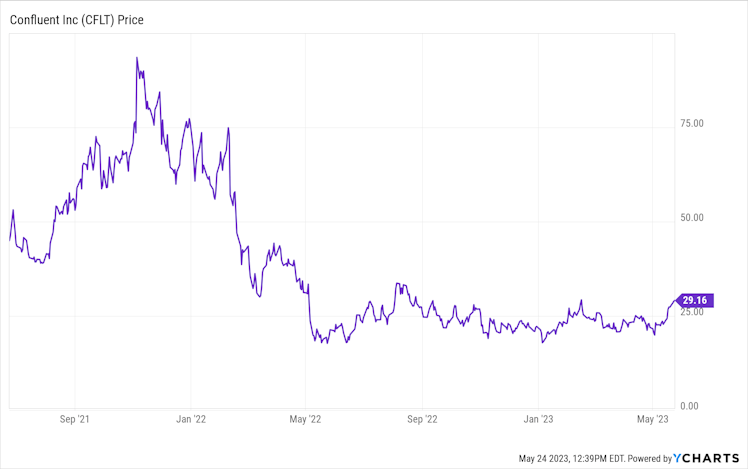
I include the stock price chart, so that investors can see how far CFLT has dropped since its peak in 2021. Granted, several other software infrastructure stocks exhibit a similar pattern, but Confluent’s drop is more pronounced. It has traded in the same range for about a year now, yet continued to grow revenue and improve profitability over that period.
The big change since 2021 has been in the valuation multiple. At its peak price over $90, the P/S ratio approached 60. Currently, the stock’s price has dropped to about $29 (down nearly 70%) and the P/S ratio stands near 13 (80% drop). We could argue that the valuation is reasonable this point and further stock appreciation would be driven by the company’s growth going forward, versus further multiple compression.
Revenue
Confluent delivered $174.3M in total revenue for Q1, up 38.2% annually. Analysts were looking for $167.4M or 32.7% growth. The company had set guidance for a range of $166M – $168M coming out of the Q4 report. On a sequential basis, Q1 revenue was up $5.6M or 3.3% over the Q4 revenue result of 168.7M.
Going back a year to Q1 2022, Confluent delivered sequential revenue growth of $6.2M for a q/q growth rate of 5.2%. The transition from Q4 to Q1 typically results in some sequential deceleration due to seasonality. In Q1 2023, we saw about the same gross dollar amount of sequential growth, but 190 bps lower on a percentage basis.
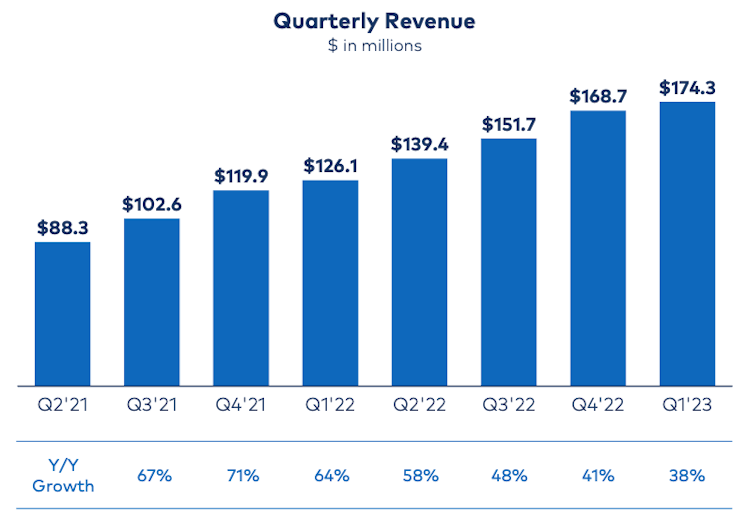
Subscription revenue grew at a faster pace than total revenue, up 40.9% y/y to $160.6M. Subscriptions account for 92% of total revenue, with the other 8% made up by services. Services includes consulting work, implementation assistance and training. These are lower margin offerings necessary to help some customers with their transition to Confluent. Subscription revenue is more indicative of demand for Confluent’s core product offering and the higher growth rate here is a benefit.
RPO provides another performance indicator for future demand. In Q1, total RPO was $742.6M, up 34.7% y/y. Total RPO for Q1 increased slightly over Q4’s RPO of $740.7M, which was up 48.0% y/y. Current RPO, which represents those performance obligations that are expected to close in the next 12 months, provides a better story. It was $477M in Q1, representing about 64% of total RPO. This was up 44% y/y and accelerated from Q4’s $456.2M or 43% annual growth. Sequentially, current RPO grew by 4.6%, outpacing the sequential revenue and total RPO growth.
On the earnings call, management referred to the same levels of budget scrutiny and elongated sales cycles that they had highlighted in Q4. In March, they observed some pressure on consumption trends in the Cloud business during the second half of the month, primarily isolated to the financial vertical. This would line up with the failure of SVB earlier in the month. Management shared that demand recovered in April (and remained stable into May, based on a recent analyst conference). For forward guidance, though, management is being conservative and are not assuming any improvement in budget scrutiny trends or the overall macro environment for the remainder of the year.
Looking forward, they project revenue for Q2 in a range of $181M – $183M, which would represent growth of 30.5% annually and 4.4% sequentially or $7.7M over the Q1 actual at the midpoint. This beat the analyst target of $181.3M by $0.7M. While this represents a small beat, the 4.4% sequential raise over Q1 is pretty favorable. Confluent beat their Q1 guidance by $7.3M or 4.4%. This means that the next bar to reach Q3’s analyst revenue estimate for $196.4M is achievable.
For the full year, Confluent management reiterated their 2023 revenue target for $760M-$765M that had been set in Q4. They could have raised this by the $7M of outperformance to their Q1 revenue estimate. However, management chose to leave it in place, in order to be conservative for the remainder of the year.
"Our point of view on the full year remains unchanged from last quarter. The demand environment remains healthy, even though it’s a tough macro out there. So, we’re reaffirming our guide for the full year, growing revenue at 30%, and plan to achieve breakeven on a non-GAAP operating margin basis in Q4.
We did not flow through the amount of the overperformance we had in the top line this quarter to the full year guide, which is really a byproduct of the macro environment and factors I’ve called out before, which we’re trying to prudently take into consideration while formulating guidance. You asked for some puts and takes. We expect cloud to continue its growth momentum with the highest NRR and an increase in sequential revenue add every quarter for the remainder of the year. And then the CRPO growth that I pointed out before, it continues to be robust." Confluent Q1 2023 Earnings Call
Like some other software infrastructure providers based on an “open core” model (MDB, ESTC), Confluent initially generated all of its revenue from licensing of their packaged software product. Customers could host this on their infrastructure and manage the operations themselves (self-managed). Several years ago, similar to peers, they realized that customers would find value in a fully-managed cloud-hosted offering and launched Confluent Cloud. It is currently available on all three hyperscalers.
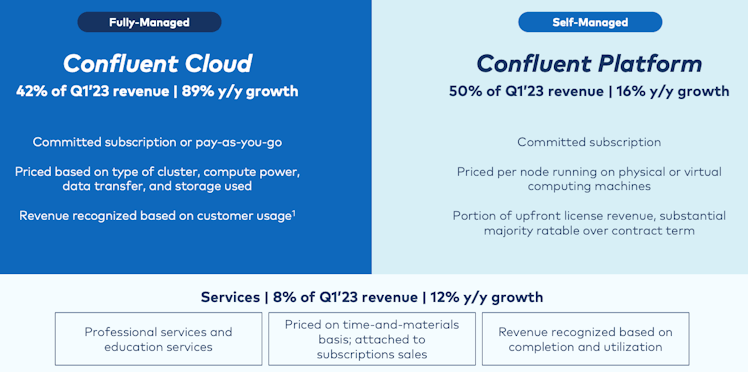
Confluent Cloud has demonstrated rapid growth, outpacing the company’s revenue performance and increasing its share of total revenue over time. In Q1, Confluent Cloud revenue grew by 89% y/y and now makes up 42% of total revenue. Confluent Cloud contributed 41% of revenue last quarter. A year ago, it accounted for 31% and just 18% two years ago. The majority of new revenue is being generated by Confluent Cloud, as it contributed greater than 50% of total new ACV bookings for the sixth consecutive quarter.
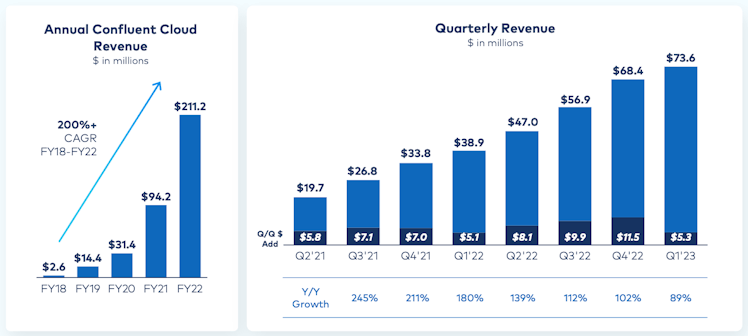
Sequentially, Confluent Cloud added $5.3M in revenue in Q1. Recall that total revenue was up $5.6M from Q4, implying that Cloud is responsible for the majority of sequential growth. On a percentage basis, Q1’s sequential growth isolated to Cloud was 7.7%. This also beat management’s expectation coming out of Q4 for $5.0M in sequential Cloud revenue. Compared to a year ago, Confluent demonstrated lower sequential growth in Q1 2022 as compared to Q4 2021, adding $5.1M in Cloud revenue. The Q1 2023 total sequential growth was higher than a year ago, but lower on a percentage basis.
Looking forward in 2023, management expects Confluent Cloud sequential revenue growth to increase each quarter, similar to the pattern exhibited in 2022. For Q2, they are estimating that Confluent Cloud sequential revenue growth is in the range of $7.5M – $8M, or 10.5% over the $73.6M delivered in Q1. This target was recently reiterated at the JP Morgan TMC Conference. That would bring Confluent Cloud to represent about 44.7% of total revenue. For the full year, management expects Cloud to reach a contribution of 48%-50% in Q4.
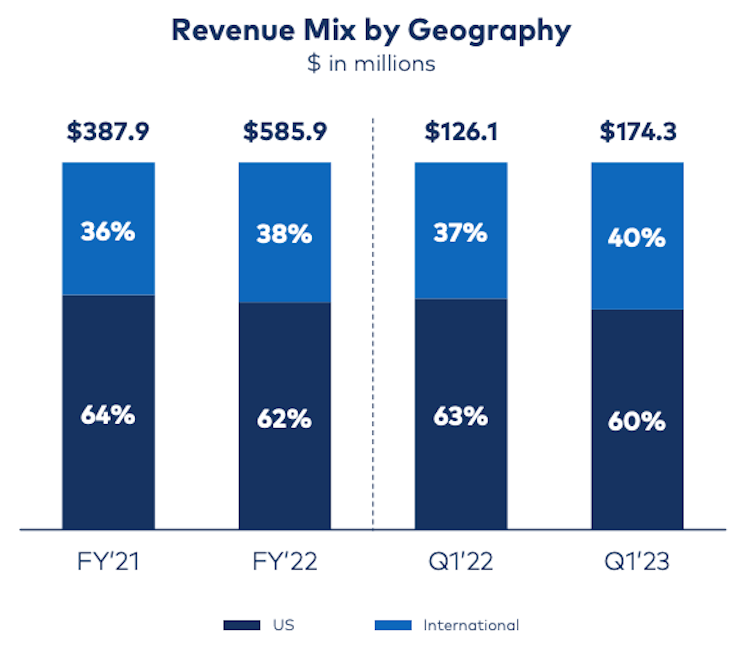
Another growth driver for Confluent is rapid expansion of the international market. In Q1, revenue from the U.S grew 32% y/y and now represents 60% of total revenue. This is down from 63% a year ago. Revenue from outside the U.S. great much faster at 49% y/y and contributes 40% of total revenue. This rate has increased from 37% a year ago. The faster growth internationally should help pull up overall revenue growth.
Additionally, improvement in FX (neutral to weaker U.S. Dollar) should provide a little tailwind for international growth. While Confluent does not perform a constant currency calculation (because it charges in U.S. dollars), international customers would experience higher prices as the Dollar appreciates. When the opposite effect happens, Confluent prices feel lower for international customers. Other software infrastructure providers have reported a similar effect (Datadog, Cloudflare, etc.) and anticipate a small tailwind as FX improves.
Profitability
As investors will recall, Confluent announced an 8% staff reduction on January 26th. While a layoff is generally a disruptive event, the company appeared to maintain its growth trajectory through Q1. This is actually a pretty bullish signal, as the period around the layoff would represent a distraction for most staff members. Management did indicate that quota carrying sales capacity and key areas of R&D were being preserved.
The objective positive financial benefit of Confluent’s 8% workforce reduction is a full year improvement in the path to profitability. Leadership expects to exit Q4 of 2023 with breakeven Non-GAAP operating margin. Previously, they had signaled that event would happen in 2024. Additionally, they expect FCF margin to follow a similar trajectory, in spite of the large step down in FCF margin in Q1, associated with the layoff.
Break-even in Q4 2023 would be a significant improvement from the -23% Non-GAAP operating margin delivered in Q1. This near 20% improvement in operating margin matches the y/y improvement relative to Q1 2022, which had -41% Non-GAAP operating margin. Guidance for Q2 2023 is for -16% Non-GAAP operating margin, representing an improvement of 700 bps from Q1.

Besides the adjustment to staffing levels, gross margin improvements are helping the drive towards profitability. In Q1, Confluent’s Non-GAAP gross margin increased to 72.2%, up 250 bps y/y. Isolated to just subscription revenue, Non-GAAP gross margin is higher at 77.5% in Q1, up 200 bps over the prior year. The difference is explained by the low gross margin of Services revenue.
As Confluent Cloud makes up a larger percentage of total revenue, it will pull down gross margin. At the same time, Confluent Cloud realizes volume discounts as it scales and the team is continually optimizing performance. Over the long term, Confluent management has targeted Non-GAAP gross margin in a range of 72%-75%, which is about 130 bps above current levels.
Moving down the income statement, Non-GAAP operating loss was $(40.3M) for an operating margin of -23.1% in Q1. This was down slightly from Q4’s -21.5%, but much improved from -41.0% in Q1 2022. The improvement year/year can be attributed to reductions in total OpEx as a percent of revenue. Contributions from R&D, S&M and G&A all decreased from Q1 2022. Most notable was the 1320 bps improvement in S&M as a percent of revenue.
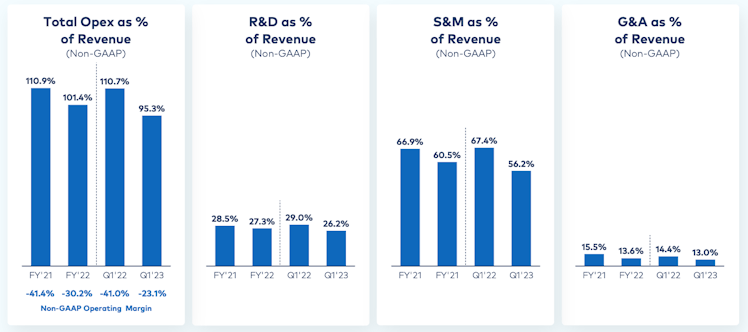
Looking forward, management projects a Non-GAAP operating margin of -16% in Q2. This would be a 700 bps improvement over Q1. For the full year, they increased the operating margin target to a range of (14%) – (13%), which is up 1% from the (15%) – (14%) range set in Q4. They also reiterated the expectation that Q4 2023 reaches break-even Non-GAAP operating margin within the quarter.
Similarly, Non-GAAP Net Loss Per Share was $(0.09) in Q1, which beat the analyst target for $(0.14) by $0.05. Coming out of Q4, the company had set a range for $(0.15)-$(0.13). Looking forward to Q2, management expects net loss per share of $(0.08)-$(0.06). Analysts had been looking for $(0.10), representing a raise. For the full year, Confluent also increased their EPS target to a range of $(0.20) to $(0.14), which is a large increase from their Q4 guidance of $(0.28) to $(0.22).
Free cash flow margin didn’t show the same level of improvement in Q1, dropping 120 bps y/y to -47.5% from -46.3% a year ago. In Q4, FCF margin was -18.3%, having improved by almost 400 bps from -22.3% in Q4 2021. The large sequential drop in Q1 was expected, however, and discussed on the Q4 earnings call. FCF in Q1 was negatively impacted by charges related to the staff restructuring, the Immerock acquisition, corporate bonus payout and the employee stock purchase plan.

The good news with cash flow is that management expects FCF margin to follow the same path as operating margin. This means we can expect it to proceed towards break-even through 2023. Additionally, management provided mid-term and long-term profitability targets. In the near to mid-term, while revenue growth remains above 30%, management expects to continue investing for high growth. Non-GAAP operating margin should reach 5% and FCF margin can hit 10%. Over a longer period, management thinks operating margin can trend towards a range of 20%-25% with FCF margin exceeding 25%.
Customer Activity
Confluent’s customer activity showed momentum, but at slower levels than in the past, as sales cycles lengthened and finance teams scrutinized expansion deals. Total customer growth had been impacted early in 2022 by a change to the sign-up process for Confluent Cloud to remove the requirement to enter a credit card. Now, new customers can access Cloud services to prepare for a migration, before incurring charges. Following the change, the paying customer count froze between Q1 and Q2 2022 and then marginally increased in Q3. In Q4, customer growth jumped to 290 in the quarter, versus 120 in Q3.
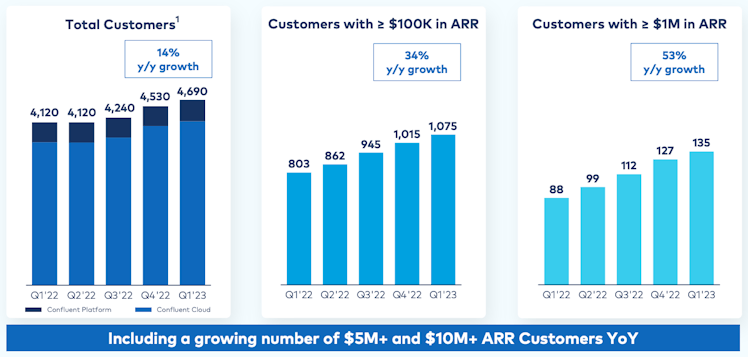
In Q1 2023, Confluent added 160 total paying customers. This is better than the 120 added in Q3, but below the 290 new customers in Q4. On a sequential basis, total customer growth was 3.5% and 14% annually. This growth in total customers has slowed down substantially and needs to be watched. A company of Confluent’s size should be increasing total customers at a higher rate, more like 20-30% year/year. This is important to provide a funnel for growth into future large customers. It’s likely that new customers are delaying the transition from free to paid to defer costs. The new sign-up process for Cloud makes this easier to drag out, as payment starts with meaningful utilization.
Confluent defines a large customer as generating more than $100k in ARR. In Q1, the company increased their large customer count by 60 sequentially or 5.9% q/q, and 34% year/year. In Q4, Confluent added 70 customers of this size, with 83 in Q3 and 59 in Q2. In the transition from Q4 2021 to Q1 2022, Confluent added 69 large customers sequentially. This means that the large customer growth of 60 in the most recent quarter falls to the lower end of the historical range. These large customers contributed more than 85% of total revenue in the quarter.
Growth of $1M+ customers is proceeding at a faster rate, which is likely the source of Confluent’s sustained revenue growth. In Q1, they added 8 more $1M+ ARR customers, growing 6.3% sequentially and 53% annually. The prior three quarters in 2022 registered high sequential growth in the low teens as well, while the transition from Q4 2021 to Q1 2022 generated no new $1M+ customers. Taking the annual cycle into account, the increase in Q1 2023 was healthy.
Management has also anecdotally pointed to strong growth in $5M+ and $10M+ customers. I think these mega customers are driving a large portion of the overall revenue growth. I like that Confluent is demonstrating high elasticity of spend to push to these levels. Their 2023 revenue target of $760M becomes easier to reach with growth in $5M – $10M customers. Their impact on total revenue can be 50-100x greater than $100k+ ARR customers.
Confluent measures the increase in spend from existing customers as their Dollar-based Net Retention Rate (NRR). This metric makes clear the source of Confluent’s continued revenue growth, in spite of the slowdown in total customer activity. Starting in 2023, Confluent management introduced a new definition for NRR. While the motivation for changing the calculation of a key financial metric is questionable, in this case, I think it makes sense.
In the past, Confluent measured NRR expansion based on the contracted spend amount. This was applied to both Confluent Platform (license subscription) and Confluent Cloud (contracted commitment). For Platform, this is fine. For Cloud, though, revenue is realized based on customer consumption. The change this year is to utilize actual consumption on Confluent Cloud for the NRR calculation. This represents a more realistic measure of customer activity, as it is directly tied to revenue. It also aligns with the methodology used by peers for NRR, including Snowflake, Datadog and MongoDB.

For Q1, total NRR (the combination of Confluent Platform and Cloud) was above 130%. In their Investor Presentation, Confluent provided historical data for both the old and new method of NRR calculation. Under the new method, NRR was over 130% for the past year (they don’t provide exact values). Using the old method, NRR was over 130% for most of 2022, dropping to “just under” 130% in Q4 and then “just under” 125% in Q1.
The CFO discussed this on the earnings call. The difference can be explained by the fact that some customers are exceeding their committed contract spend on Confluent Cloud in their actual consumption of the service. This likely reflects their hesitancy to commit to large contracts in the current environment, but also the reality around the need to continue heavy use of Confluent Cloud resources.
We will want to watch the trajectory of this new NRR measure closely. It could take one of two paths. Either customers start limiting their consumption to match what they had contracted (which would lower NRR) or they acknowledge the consumption and increase their contracts (which would maintain NRR). In either case, the current level of NRR over 130% is pretty robust in this spend environment.
Confluent also shares that NRR isolated to just the Cloud product is even greater than the 130% for total NRR. This would be expected given Cloud’s higher revenue growth rate. As Cloud makes up a greater portion of total revenue, this higher NRR for just Cloud may help prop up overall growth rates.
Finally, Confluent management shared that gross retention was over 90%. Where NRR accounts for all changes in customer spend (expansion, contraction, attrition), gross retention removes expansion, reflecting the year/year impact of attrition and contraction of spend. In this context, gross retention over 90% is pretty good and also highlights that just expansion would be much greater than 130%.
Combining the NRR metrics with those around customer growth, it becomes clear that Confluent is driving a lot of their revenue from expansion of existing large customers. This is the ideal case, as helping existing customers expand their use of Confluent Cloud is easier than hunting for new customers. At the same time, this growth from existing customers will eventually taper off. I would like to see Confluent increase the rate of new customer growth. For comparison, both MongoDB and Datadog have maintained total customer growth above 20% annually in the most recent quarter.
Investment Plan
Confluent is pursuing a large addressable market that is anchored in the broad adoption of Apache Kafka across enterprises. The expected return on investment from improved data infrastructure is bolstered by the case for enterprises to leverage their proprietary data sets to create new AI models. These make an argument for raising the priority of data streaming projects in C-level punch lists, as evidenced by Confluent’s recent survey data.
As Confluent continues to add more capabilities to their packaged solution around core Apache Kafka, organizations will feel an increased pull to migrate from self-managed Kafka to Confluent’s offering. Confluent Cloud makes this TCO argument more compelling, as the Confluent team adds infrastructure management to the mix. Enterprises often need to maintain their own sizable teams of operations engineers to configure and manage their large Kafka installations. This can all be outsourced to Confluent, allowing those resources to be shifted to real value creation.
The addition of stream processing capabilities through a managed service for Flink will increase Confluent’s market opportunity. Management estimates that stream processing revenue could eventually approach that of core data streaming. Confluent plans to have a generally available Flink managed service ready by end of 2023 and recently announced an early access program for select customers.
In Q1, Confluent delivered favorable results in spite of the same demand pressures highlighted by other software infrastructure providers. Revenue growth exceeded targets in Q1 and the company maintained their projections for the remainder of the year. Profitability showed a nice improvement with beats on EPS and significant improvement expected in operating and FCF margin through the remainder of the year. Q4 is still expected to reach operating margin break-even, with FCF margin following the same trajectory. The long-term financial model was updated to include a projection for FCF margin to reach 25% at scale.
Customer activity in Q1 was mixed. Total customer additions are lagging and need to increase into the 20% range to keep the pipeline full. Customer spend expansion, on the other hand, is healthy with NRR exceeding 130%. Granted, Confluent realized a bump in NRR by shifting measurement to a consumption basis, but this is how peers measure spend expansion. Isolated to Cloud, NRR is even higher than the 130% threshold.
As I am wrapping up this post, Snowflake just reported their latest results. While they beat on Q1 product revenue targets by about 500 bps of annual growth, they once again lowered their full year product revenue target from 39.5% annual growth to 34%. They attributed the cause to continued impact from customer optimization. Specifically, the CFO called out a slowdown in consumption starting in early April (Easter on April 9th) through May. Some of their largest customers also reduced data retention from 5 years to 3 years.
Providing a check on this trend, Confluent’s CEO was interviewed at the JP Morgan Global Technology, Media and Communications conference the day before on May 23rd. The analyst asked about customer demand trends in May. He pointed out that in Confluent’s Q1 report on May 3rd, they indicated a dip in consumption trends in March, but that had since recovered in April. The CEO replied that they “feel pretty good about what (guidance they) gave in the earnings call.” He further reiterated the sequential Confluent Cloud revenue growth target of between $7.5M to $8.0M.
All of this provides a positive backdrop for Confluent going forward. Since earnings, the stock has appreciated from just below $20 to reach its ATH for 2023 of nearly $30 recently, approaching a 50% gain. Relative to peers growing in the 30% range with improving profitability, CFLT appears reasonably priced. They enjoy a favorable competitive position in a growing addressable market, with AI activity likely providing another tailwind.
Since the last earnings report, I have increased my allocation to CFLT slightly and will continue to monitor progress through the year. Given that CFLT is still far below their ATH of $93.60 and the demand backdrop (in spite of macro) remains strong, I will likely keep gradually increasing the portion of my portfolio that CFLT occupies over time.
jpmorgan.metameetings.net
MetaMeetings v2
Already have an account?